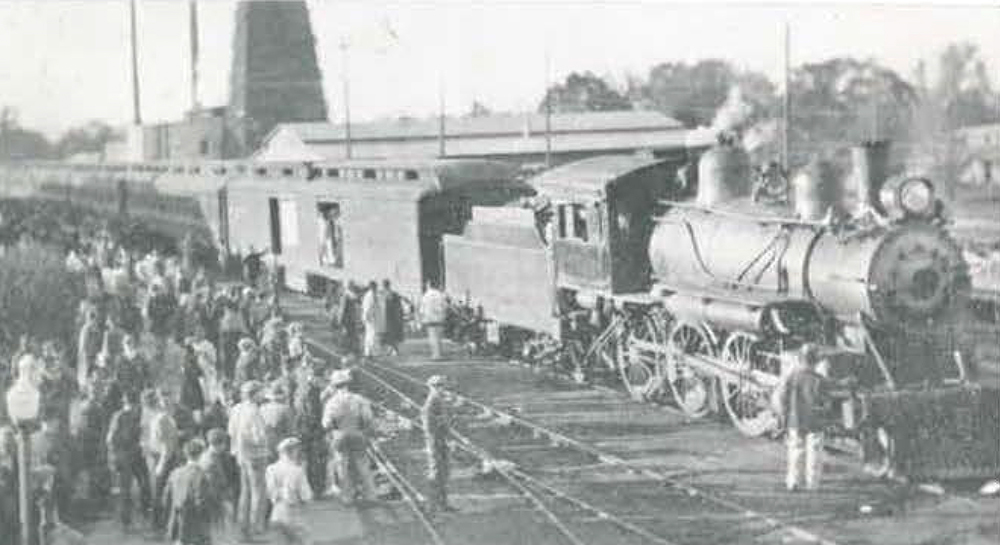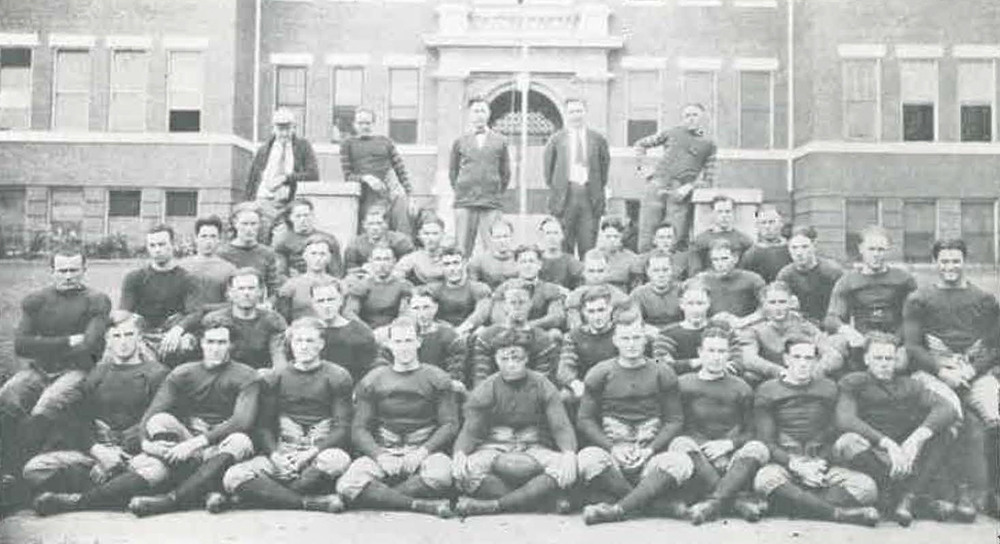One hundred years later, it might still be the most ambitious adventure ever undertaken by a traveling party from Arkansas Tech University.
On Nov. 10, 1923, the football team from what was then known as the Second District Agricultural School — among them many of the same young men who had first earned the Wonder Boys nickname just three years earlier — mounted the courage to take on one of the preeminent college football programs of the age: the U.S. Military Academy at West Point, N.Y.
Despite newspaper predictions supporting their cause, the game did not go well for the Wonder Boys. Perhaps it was because John Tucker — known to generations of the Arkansas Tech family as the ‘Original Wonder Boy’ — was injured and did not play. We’ll never know.
What we know for sure is the 104 souls who made the more than 3,000-mile train trip helped spread the reputation of the school like never before and returned home with stories they no doubt told for the remainder of their lives.
The idea of assembling a traveling party to accompany the Wonder Boys on their trip to West Point was conceived by the Rotary Club and the Lions Club in Russellville. Cost for the 10-day trip ranged from $128.85 to $133.60 per person depending upon accommodations, not including meals.
It was sold to the public in an Arkansas Gazette newspaper article as “your biggest opportunity to assist in advertising agriculture in Arkansas to the North and East.”
The majority of the traveling party boarded the train in Russellville at 4 p.m. Tuesday, Nov. 6, 1923. Others joined during stops in Morrilton, Conway and Little Rock.

Conductor C.D. Kenney of Little Rock was at the helm of the Pullman train throughout the trip. W.O. Young, interim president and secretary of the Second District Agricultural School, coordinated the itinerary for the school representatives on board. I.C. Caldwell of the Missouri Pacific Railway served as traveling passenger agent.
Passengers included Second District Agricultural School President Hugh Critz (who was on sabbatical that academic year and returned to his home in Starkville, Miss., following the game at Army) and a number of faculty members, including Mildred Shoptaw (stenographer), Marie Johnson (poultry), Nora Brown (English) and D.L. Weldon (animal husbandry).
More than 30 Second District Agricultural School students made the trip, including a group of honors students whose fares were paid for by what the Courier-Democrat newspaper described as an “out-of-town organization.” They were Pat Hamm, president of the senior class and editor of the Agricola yearbook; Veda Vaughn, president of the literary society, president of the drama club and captain of the girls’ basketball team; Ben Pruett, president of the agricultural club and a state stock judging contest champion; Dennis Rose, editor-in-chief of the Tuba Agricolae newspaper and member of the band and the orchestra; and Clyde Magness, who had recorded the highest grades at the school three semesters running.
Additional students on the train included Jim Myover, Thomas Todd, Joe Bishop, Bunyan Webb, Edgar Vaughn, Cecil Stanford and Hermoine Bondy.
Then there were Coach E.O. Brown and the 1923 Wonder Boys: John Tucker, Paul Thompson, Charles “Foots” Clement, G.W. Hamm, Clark Reasoner, Hays Gibson, Oral H. McIlroy, C.B. Smith, Denton Powers, Burl Webb, Paul Leming, Harold Ganner, White Bennett, Joe Lyons, Henry Hamilton, Jim Hugh Arrington, Arch Bewley, Autrey Newman, William Rogers, George Stokes, Jim White, Joe Bennett, Pug Edwards and Carroll Jones, as well as their water boy, Joe Sidney.
Russellville community members on board included Jack Walker, John Ferguson, Mr. and Mrs. Hedge McClanahan, Mr. and Mrs. Elbert Garrett, Mrs. J.L. Tucker (mother of the Original Wonder Boy), Mrs. John Tucker (wife of the Original Wonder Boy), Irene Howell, Mr. and Mrs. W.H. Eustice, Loyd Reed, John Swilling, John G. McFadden, William Shoptaw, Raymond Trammell, Mr. and Mrs. L.B. Walthall, Mrs. Ed Bernard, Mr. and Mrs. B.C. Fowels, Mr. and Mrs. Ed Harkey, Mrs. W.H. Norwood, Dr. G.C. McKennon Jr., “Big Bob” Smith, Van Boswell, Mart Maloney, John Wells, Frank Howell, E.L. Johnson, Dr. R.L. Smith, Joe Sosbee, J.A. Livingston, J.S. Bonds and Oda Bowden.
An additional two dozen supporters from across Arkansas joined the party.
Stops along the way to West Point included an opportunity for the Wonder Boys to practice on the National Mall in the shadow of the Washington Monument, a dispensation made possible by special permit acquired by the office of Arkansas Senator Thaddeus Caraway. After practice, the Wonder Boys climbed to the top of the 555-foot tall monument.
“The Wonder Boys are said to be the first squad to scrimmage on the mall and ascend the monument in football uniforms,” wrote the Arkansas Gazette.
The train’s baggage car was filled with products created at the Second District Agricultural School. It was a combination of agricultural goods, items produced in the school shop and products of the school’s domestic science program.
The Arkansas Gazette reported that it “will resemble a county fair exhibit hall” and that “the display will be valuable advertising for the state.”
The exhibit car had cloth signs on both sides that read “Agricultural Exhibit Car, State Agricultural School, Russellville, Ark., Wonder School of the Wonder State.”
A large, electric sign on the back of the exhibit car read “Aggie Special: Russellville, Ark.”
Stops in Carlyle, Ill., and Flora, Ill., attracted larger crowds than the exhibit car could accommodate.
As the train made its way north and east, Nora Brown was noted to lead the travelers in their favorite cheer: “Is everybody happy? Well, yes.”
According to the Arkansas Gazette, the spectacle “attracted attention everywhere, and there were many expressions of surprise that so large a party would travel so great a distance on such a mission.”
Those expressing surprise were clearly unfamiliar with the fervor the Wonder Boys football team had stirred in its part of the country.
The journey to West Point began in 1919 when a Russellville resident, John Tucker, joined the Second District Agricultural School football team. E.O. Brown was hired as head coach the following year, and when the team defeated Henderson-Brown College 13-0 on Nov. 16, 1920, it earned the nickname Wonder Boys courtesy of an Arkansas Gazette headline the next day.
It was the beginning of a golden age for Arkansas Tech football. The Wonder Boys went 7-0 in 1921, outscoring their opponents by a cumulative score of 270-7. They were 8-1 in 1922, with their only loss coming in a 14-12 setback at the University of Tulsa.
In the weeks leading up to the game against Army in 1923, the Wonder Boys avenged the 1922 loss to Tulsa with a 50-7 triumph over the Golden Hurricane and amassed a record of 4-0-1.
Based upon the strength of the win over Tulsa, the Arkansas Gazette published a headline that stated “Aggies Figure They Have Good Chance Against the Army.”
Another article, perhaps more tethered to reality, pointed out that the Second District Agricultural School was “probably the smallest school ever matched to play the Army Cadets.”
Nonetheless, that same article observed that the game between the Wonder Boys and Army was “attracting attention all over the country and is labeled as one of the biggest sporting events of the season.”
The Second District Agricultural School team went to sleep in the barracks at West Point on Friday, Nov. 9, and awoke on a clear and crisp Saturday morning near the site of competition.
Two factors conspired against the Wonder Boys. First, Army had suffered a loss to Yale the previous week and arrived at the stadium ready to exercise their frustrations. Then there was the loss of Tucker to injury. Additional injuries to Thompson and Leming during the game did little to help the Wonder Boys’ chances of pulling off the upset.
“Every Aggie fan still believes that if the mighty John had been in condition, he would not only have run up a good score against the Army, but would also have held the Cadets to two or three touchdowns,” wrote the Arkansas Gazette in its post-game coverage. “His individual effort, coupled with his generalship and the confidence he would have given the team, might easily have turned defeat to victory.”
That vote of confidence for Tucker notwithstanding, Army won the game 44-0.
“The team feels no sting over the defeat,” wrote the Arkansas Gazette. “The fans are in good spirits and will leave Sunday night on their homeward journey, disappointed over the game, of course, but game enough sports to take it manfully and get the greatest possible enjoyment out of the remainder of the trip.”
The Second District Agricultural School traveling party did just that, beginning in New York City. The Arkansas Gazette reported that ascending the Woolworth Tower — at the time the tallest building in the world at 792 feet — or taking a ride on the subway were among the priorities for the tourists.
“Depend upon an Arkansan to want to go to the limit, whether up or down,” wrote the Gazette.
Fortunately, even the boldest among the traveling party remained on solid ground when the train stopped at Niagara Falls for a five-hour visit.
Upon passing through the southern edge of Canada, the Second District Agricultural School group stopped in Detroit and toured the factories of the Ford Motor Company. Afterwards, the Aggie Special headed south to Chicago and then back home to Arkansas. The train pulled into Russellville at 10:30 a.m. on Thursday, Nov. 15, 1923.
“An agreeable surprise to many of the tourists was the hospitality of the people of the North and East,” wrote the Arkansas Gazette. “Some went so far as to admit that Southern hospitality would not compare with theirs. Old friends were met everywhere who were ready to proffer the hospitality of their respective cities. New York, Detroit and Chicago strangers offered their services as guides and suggested places of interest to visit when they learned the tourists were sightseers in a strange land.”
The newspaper account went on to state that L.P. Dutch, an advertising salesman in New York, spent the entirety of Sunday, Nov. 11, with the Wonder Boys to ensure they could see as much of New York City as possible.
“While the football game was the premier event, every day had its special attractions and the trip will remain an epochal event in the lives of many, especially the 30 or more students, including the football team,” the Arkansas Gazette continued in its summary of the adventure. “A happier, jollier bunch would be hard to get together for any trip.”







